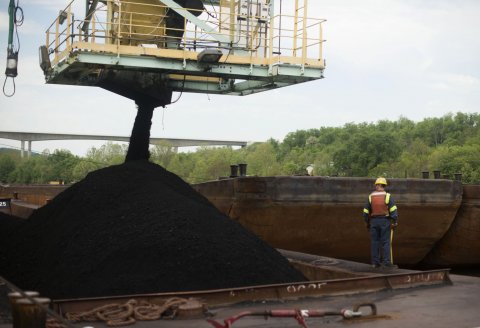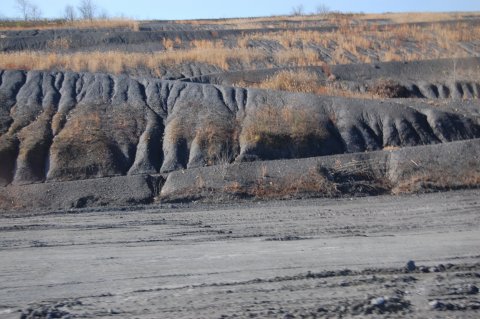
Marcus Santos entered Fayette State Correctional Institution a relatively healthy man; he had rarely been sick and had never had asthma or allergies. The only medication he took was a daily dose of Lisinopril, to curb his high blood pressure. Before being locked up in Fayette, a maximum-security prison in LaBelle, Pennsylvania, Santos lifted weights every day and prided himself on his body and his muscles.
But soon after arriving at Fayette, he began to experience symptoms that suggested there was something seriously wrong. First, it was a nosebleed. Then headaches. Six months into his sentence, Santos was frail and in near-constant pain. At this point, his symptoms included severe, unexplainable welts and swelling all over his body. There were rashes and hives covering his armpits, his sides and the back of his neck. His feet, genitals and even his eyeballs all swelled at some point.
No one seemed to know what was wrong with Santos, now 41, who was serving a five- to 10-year sentence for selling cocaine. The doctors attacked his symptoms with a battery of allergy medications, but nothing worked. He began to feel desperate. Some nights, he'd stay up until 5 a.m., scrubbing his mattress with bleach, thinking bedbugs were biting him. He didn't sleep long enough to get nightmares. It was agony. Santos became a fixture in the prison's infirmary. Eventually, one of the doctors suggested his symptoms might be caused by an allergic reaction to something in the air, perhaps pollen.
But the source of Santos's problems was probably far more insidious. LaBelle is a rural town in the southwest foothills of Pennsylvania, near the border of West Virginia and Ohio. The prison sits on the banks of the Monongahela River, a tributary for barges hauling coal to steel mills in Pittsburgh. It's also adjacent to a massive coal ash dump site. For years, LaBelle residents, and more recently prison guards at Fayette, have complained that the site has been making them sick. In the winter, Santos had noticed something odd: a layer of black dust that settled on the white snow. And so he began to wonder. Was coal ash in the air making him sick?

'If You Make It…'
As the sun set over Western Pennsylvania on August 26, 2012, Santos felt his throat closing, cutting off oxygen to his lungs. He trudged over to the medical unit, where the male nurse on duty took his blood pressure. It was 166 over 102. The nurse then took his temperature, which was 98.8 degrees. The nurse then checked his breathing. "Lungs clear," the nurse wrote in his notes. "Heart rate and rhythm normal." Then she gave him two Tums tablets and told him, "If you make it, you make it." (The Pennsylvania Department of Corrections [DOC] declined to comment for this story.)
"If you make it, you make it," Santos repeated to himself, disgusted. He sat alone in his cell, thinking of his 12-year-old son, while waiting to see if he was going to live or die. Seconds turned to minutes. Minutes turned to hours.
Slowly, but surely, the swelling went down. Oxygen passed through his lungs. Santos could breathe.
"I've been shot at. I've been cut," Santos told me recently. "I'm not no little preppie good guy. I've had my time on the streets. But when your body is turning against you because there's something that's out of your control, and you can't do anything about it, it changes you."
Fugitive Dust
When coal is extracted from the earth, it needs to be washed and processed. Until the mid-1990s, LaBelle operated one of the largest coal prep plants in the world. Years of washing coal created tons of waste, and by the mid-'90s, when its owners abandoned the site, LaBelle was home to a massive pile of this "slurry."
Untended piles of coal waste can pollute the local environment, so in 1996, the Pennsylvania Department of Environmental Protection (DEP), along with a local company, Matt Canestrale Contracting (MCC), began dumping coal ash onto the site. This process—known as coal ash reclamation—is designed to stabilize the local ecosystem. On paper, it's an innovative solution. Power plants around the country create tons of ash waste each year, and they need somewhere to dispose of it. Sites like the one in LaBelle are considered ideal because, theoretically, the dumped ash will solidify with the slurry, which prevents leaching, stops the spread of area pollution and makes the site generally more habitable. It's win-win, in theory.
However, many are skeptical that the benefits of reclaiming the site outweigh the risks of dumping coal ash in a populated area. "Some of the substances in coal ash are the most toxic elements on the planet," says Barbara Gottlieb, the environment and health director at Physicians for Social Responsibility. In 2010, Gottlieb wrote a report on the effects of exposure to coal ash, which concluded that "coal ash toxics have the potential to injure all of the major organ systems, damage physical health and development, and even contribute to mortality."

Problems arise when the coal ash gets into the environment. For instance, if the site isn't properly lined with clay and a plastic tarp, Gottlieb says, coal ash can leach into streams, affecting local wildlife and potentially poisoning drinking water. And because the ash can be fine and powdery, it can blow off from trucks or barges if not covered properly. This is called "fugitive dust," and it's extremely dangerous.
Gottlieb says people can get sick from fugitive dust in several ways. The most obvious is through inhalation. But the dust can also be absorbed into skin, causing a variety of cancers, ulcers, hives and irritations.
Paul Wright, director of the Human Rights Defense Center (HRDC), estimates that dozens of U.S. prisons have been built near polluted sites in the past 15 years. However, there's very little reliable data on the subject, which is why Wright, working with Prison Ecology, a project that grew out of the HRDC, plans to map out all the U.S. prisons near toxic dump sites. In the meantime, Prison Ecology has begun a campaign to prevent the Federal Bureau of Prisons from building a prison on top of another former coal mine, in Letcher County, Kentucky.
Wright says there's one huge reason former coal towns welcome prisons: money. The declining coal industry has left scores of impoverished rural towns. That, coupled with the fact that the United States was opening a new prison every 15 days throughout the '90s, created a toxic mix. Affluent towns almost never allow prisons near residents, but coal towns like LaBelle, where the per capita income is around $20,000, are much more accommodating.

In 2000, Pennsylvania was closing an inner-city prison in Pittsburgh, and the DOC was looking for real estate to build its next facility. It chose LaBelle, promising 700 new jobs for local residents but not mentioning the proximity to the coal ash dump site. "If you're a glass is half-full kind of person, you'd say they're repurposing the abandoned coal mine" and using it to create jobs, says Wright. "And if you're a glass is half-empty kind of person, you'd say it's pretty unconscionable that you're putting people in cages at gunpoint and putting them in toxic waste sites."
On a recent visit to LaBelle, I met with Jim and Candy Harvey. We sat on a wooden bench in front of the local firehouse. They recently moved out of LaBelle to another small town up the Monongahela River, but their grown children and three grandchildren live in their old home, in the center of town.

Candy says her grandchildren are ill constantly. "I call them Typhoid Mary and Fred," she says, looking wistfully over the abandoned baseball field nearby. Jim says that in the summer he'd see a black film settle on the surface of their aboveground pool. Residents have complained for years about pollution in the area, but nothing is done. "People feel that it's too daunting," he says. "How can we little people get going on this?"
On June 26, 2013, the Citizens Coal Council, a coal industry watchdog, filed a lawsuit against MCC, the company that owns and manages LaBelle's coal ash dump site. The lawsuit alleges that both the air and water had become polluted, and that MCC was liable because of the company's "failure to cover trucks hauling coal ash waste," which created fugitive dust. According to the complaint, water samples taken at the site in 2012 "revealed potentially harmful levels of antimony (0.26 mg/L); boron (4.31 mg/L); and lead (0.21 mg/L), all of which exceeded government standards." It also noted that the state DEP had issued notices of violation to MCC nine times, from 1999 to 2012.
However, the lawsuit does not make any claims about health effects, which are notoriously difficult to prove. And while the suit does bring up the fact that 50 families live in the LaBelle area, it does not mention that LaBelle is also home to a prison with more than 2,000 inmates, who are closer to the dump site than most of the houses in town.
William Gorton III, the attorney representing MCC, tells Newsweek, "There's been no evidence whatsoever about the health issues related to the people in LaBelle."

Jim and Candy Harvey don't buy it. They believe that everyone in the area is affected: residents, inmates and prison guards. In April 2015, the couple created an organization called Helping Organize to Protect our Environment, or HOPE, and invited LaBelle residents to attend a screening of a documentary about coal ash. They are also sending health surveys to residents.
A Bit 'Out-There'
On April 12, 2013, Marcus Santos was sitting in the prison common room, idly flipping through the TV channels when a program came on that caught his attention: a news segment about coal ash in LaBelle. One resident interviewed said he and his wife had battled cancer and showed the side of his home, blanketed in black dust, which he claimed tested positive for coal ash. Another couple interviewed for the show were on kidney dialysis.
After seeing that, Santos sent a letter to the Human Rights Coalition, an advocacy group that fights for civil rights for prisoners. He described his symptoms, the proximity of the prison's location to the coal ash dump, and how many of his fellow inmates, as well as LaBelle residents and prison guards, seemed to be getting sick. "I understand that this letter may make me sound a bit 'out-there,'" Santos wrote. "But even a brief investigation will truly show what is going on in this area. And that this can NO LONGER be ignored or covered up."
After Dustin McDaniel, a young civil rights attorney in Pittsburgh who runs the Abolitionist Law Center, read the letter, he, along with folks from two other organizations, sent out 160 health surveys to inmates at Fayette. They got 75 back.
The responses shocked them. Eighty-one percent of the responding prisoners reported respiratory, throat and sinus conditions; 68 percent experienced gastrointestinal problems; 52 percent reported adverse skin conditions, including painful rashes, hives, cysts and abscesses; and 12 percent reported being diagnosed with a thyroid disorder. All of these numbers were significantly above what's considered normal.
McDaniel published his report online, and that finally pushed the DOC to launch its own study of health conditions at Fayette. On New Year's Eve 2014, the DOC published a report that focused on cancer rates in the prison and concluded that "there isn't an indication the environment contributes to the risk, and there are no environmental data demonstrating human exposures to significant levels of carcinogens."
Sitting in his home office under a portrait of Maximilien Robespierre, the French revolutionary, McDaniel gets visibly agitated when I bring up the DOC report, which he calls "their bullshit investigation." The problem, he says, is that the department looked only at cancer and ignored all of the other illnesses rampant in the prison.
"Health is a human right," McDaniel wrote in his initial report, "and if the patterns that have emerged during our investigation are indicative of the harms and risks that accompany confinement at SCI Fayette, then it is imperative that the prison is shut down."
Since September 2014, McDaniel has been filing dozens of right-to-know requests with the DOC about air quality in the prison. He's also trying to expand the results of his initial survey. McDaniel has now sent every Fayette inmate a health survey. So far, he's received about 500 responses, and he says the low response rate is due to the fact that many inmates fear retribution. At least five or six inmates have sent surveys to him indirectly, through relatives.
Trial Avoidance
On November 27, 2012, Santos, wearing a red jumpsuit and with shackles on his wrists and ankles, entered the office of Dr. David Skoner, an allergist at Allegheny Health Network, a hospital 40 miles north of the prison. He complained of facial rashes and swelling all over his body. Skoner pricked Santos's forearms repeatedly, drew 13 vials of blood and ran several tests to determine allergies. He also recommended that Santos start taking the over-the-counter antihistamine Claritin, avoid soy and limit his exposure to dust mites.
The allergy tests came back negative.
Six weeks later, Santos was back in Skoner's office. This time, the allergist was extremely concerned. The symptoms persisted, and he feared Santos's conditions might be getting worse. They presented, he says, a "severe and new life-threatening problem that was unexplainable."
Except there was one clue: Skoner says the symptoms were "very unique to this facility with his history. He didn't have this as a child. I figured there had to be some new dietary or environmental thing that was triggering it. But there was nothing new in his diet. It was the same all the time. So the environment had to have changed."
On Santos's medical form, Skoner made his recommendation: "Cannot rule out triggering by unidentifiable water/air exposure in prison environment. Only way to prove is trial avoidance. I recommend three months' trial in another institution to further investigate causality." Santos was transferred to a state prison in Smithfield, Pennsylvania, about three hours northeast of LaBelle.

'I Almost Drowned Myself'
Santos is dressed in black jeans, a gray Henley shirt and a black baseball hat when I meet him in May at Above Da Rim, a car shop in Harrisburg, Pennsylvania. He has a pencil-thin chin-strap beard that seems to trace the contours of his smile. "You hungry?" he asks. We hop in his car and drive over to his favorite Mexican restaurant, where he orders us steak burritos.
On the day of his transfer out of the Fayette prison, Santos says, he arrived in his new cell and began organizing his things. He was thirsty, but when he looked over at the sink, he recalled the heartburn he would get from the Fayette prison water. But here in Smithfield, his inmates assured him, the water was fine.
Santos is an effusive guy, a good storyteller. Hunched over his burrito, he mimics drinking one cup of water. Then another. And one more. He pauses, looks me in the eye for a moment, then bursts out laughing. "Man!" he says. "I almost drowned myself in that water. It was so good. It felt so good."
Santos says that after just six months at Smithfield, his symptoms started going away. Within a year, he was up to "95 percent." In March 2015, Santos was granted parole. He's now at full health and is adjusting to life outside prison, spending time with his son and family and figuring out how to make phone calls on his new Samsung smartphone. "Phones got big again, man," he says with a wide grin. He even went on a date recently.
Santos keeps in touch with McDaniel. He's happy the lawyer is investigating the prison, and he's eagerly awaiting the results of the new survey. He knows the stakes are high. If the results indicate that prisoners at Fayette are getting sick at abnormally high rates, the DOC might be forced to launch a full epidemiological study of inmate health at the prison. And if the department finds conclusive evidence that inmates are getting sick from coal ash in the area, it may be forced to shut down the prison.
Santos didn't want to talk about his role in this investigation, and he refuses to take credit for it. Mostly, he just wants to hear about the physician who got him out. "If it wasn't for Dr. Skoner, I know I wouldn't be having this conversation with you. There's no way around it. I owe my life to that man."
Eric Markowitz is a senior writer with the International Business Times. Follow him on Twitter @EricMarkowitz.














